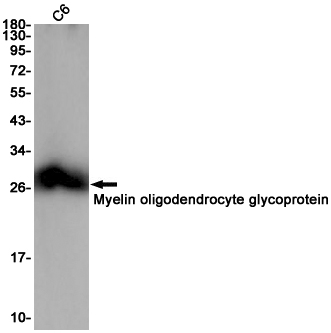
| WB | 1/500-1/1000 | Rat |
| IF | 1/20 | Rat |
| IHC | 咨询技术 | Rat |
| ICC | 技术咨询 | Rat |
| FCM | 咨询技术 | Rat |
| Elisa | 咨询技术 | Rat |
| Aliases | BTN6; BTNL11; MOGIG2; NRCLP7 |
| Entrez GeneID | 4340 |
| WB Predicted band size | Calculated MW: 28 kDa; Observed MW: 28 kDa |
| Host/Isotype | Rabbit IgG |
| Antibody Type | Primary antibody |
| Storage | Store at 4°C short term. Aliquot and store at -20°C long term. Avoid freeze/thaw cycles. |
| Species Reactivity | Rat |
| Immunogen | Recombinant protein of human Myelin oligodendrocyte glycoprotein |
| Formulation | Purified antibody in TBS with 0.05% sodium azide,0.05%BSA and 50% glycerol. |
+ +
以下是关于MOG抗体的3篇代表性文献摘要:
1. **标题**:MOG antibody-associated encephalomyelitis in children: A national population-based cohort study
**作者**:Höftberger R, et al.
**摘要**:该研究分析了儿童MOG抗体相关中枢神经系统脱髓鞘疾病的临床特征,发现其症状包括视神经炎、横贯性脊髓炎和脑炎,且对免疫治疗反应良好,但部分患者可能出现复发。
2. **标题**:MOG-IgG in NMO and related disorders: A multicenter study of 50 patients.
**作者**:Jarius S, et al.
**摘要**:研究比较了MOG抗体与AQP4抗体阳性患者的差异,指出MOG抗体患者更易出现视神经炎和广泛脊髓病变,且核磁共振成像(MRI)病灶分布不同,总体预后较好。
3. **标题**:The pathology of central nervous system inflammatory demyelinating disease accompanying myelin oligodendrocyte glycoprotein autoantibodies.
**作者**:Takai Y, et al.
**摘要**:通过病理学分析,揭示了MOG抗体相关疾病的中枢神经脱髓鞘特征,包括少突胶质细胞损伤和炎性细胞浸润,与多发性硬化(MS)的病理机制存在显著差异。
4. **标题**:Diagnostic relevance of MOG antibody persistence in acquired demyelinating syndromes.
**作者**:Waters P, et al.
**摘要**:探讨了MOG抗体持续阳性与疾病复发的相关性,提出抗体滴度动态监测对预测病情进展和指导治疗(如免疫抑制剂使用)具有重要价值。
Myelin oligodendrocyte glycoprotein (MOG) is a protein located on the surface of myelin sheaths in the central nervous system (CNS). Antibodies targeting MOG (MOG-IgG) are associated with immune-mediated demyelinating disorders, particularly in children and adults with conditions such as neuromyelitis optica spectrum disorders (NMOSD), acute disseminated encephalomyelitis (ADEM), and optic neuritis. Unlike aquaporin-4 (AQP4) antibodies, which are specific to neuromyelitis optica, MOG antibodies define a distinct clinical entity with varied phenotypes. MOG antibody-associated disease (MOGAD) often presents with optic nerve, spinal cord, or brain inflammation, but tends to have a more favorable prognosis compared to AQP4-positive NMOSD.
The discovery of MOG antibodies gained momentum with advances in cell-based assays (CBA), improving detection accuracy. While MOG is a native myelin antigen, its role in autoimmune pathology remains unclear, though antibody-mediated demyelination via complement activation is hypothesized. Diagnosis relies on clinical features, imaging, and serological confirmation. Treatment often includes corticosteroids, intravenous immunoglobulins (IVIG), or immunosuppressants, though standardized guidelines are lacking. Research continues to clarify long-term outcomes, relapse risks, and optimal therapeutic strategies, emphasizing MOGAD’s recognition as a unique neuroinflammatory disorder.
×